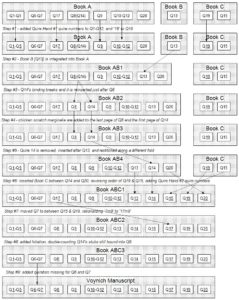As promised, here are some preliminary slides for my upcoming Villa Mondragone / Voynich 2012 presentation, though not yet with any pictures to illustrate them (boo! hiss!).
Essentially, I’ve wrapped together all my various codicological analyses from the last decade into a single mega-sequence: these explain the step-by-step transformations that I’m fairly certain the Voynich Manuscript underwent once people started adding extra layers (quire numbers, marginalia, folio numbers, etc) to it.
Download the slides here: Between Vellum and Prague.
There’s also a mega-diagram handout to go with it: click on the following picture to expand it out into something you can navigate more effectively. The key graphic convention to note is that I’ve used underlines to denote where quire numbers were physically added (and on which individual digit!)
Ultimately, I think I’ve now managed to reach a level of codicological narrative that explains more or less everything that happened to the manuscript once it landed on the first quire numberer’s desk (though a question mark remains hanging over ‘Q6’, Quire #6 *sigh*). Having said that, I’m perfectly happy for you all to try to shoot any part of it down in flames… I wouldn’t present it to an international conference if I wasn’t reasonably convinced it was basically bulletproof. 🙂
Further reading:
* For basic background, my introduction to the Voynich Manuscript’s quire numbering
* For much, much more on the ‘chicken scratch’ marginalia (and on Q8 and Q14), take a look at these posts: 1, 2, 3, and 4.

From my vantage point (previously as custodian of the record) it will be a very good show. If you use Power Point, be sure to speak slowly and loudly (mike or not). The odds are that at least 30% of the audience will have significant hearing impairment and/or impaired vision.
Will you be having a Q & A session with the audience after you’ve all given your presentations?
No more Q’s from me until after you get home. Most of all, HAVE FUN! Tell Rich Santa Coloma, for me: 3-D — the first time I tried to watch a 3-D movie (with the color cellophane lenses, I got a dreadful headache. No headache with Rich, thank goodness!
Nick, and anyone else who might be interested:
I spent several hours online researching the processes of a scriptorium. You may already be familiar with all or most of these but you may want to add them to your presentation notes:
Incipit: Formulaic beginning of text
Explicit (literally, unfolded”) a formulaic marking at the end of text or part of the text, is sometimes confused with “colophon”
Ms’s acquired for monastic/secular library often have an “ex libris” mark for provenance (?)
Materia operus: indice/chapter heading — for reference material (my Q: medical? religious? history?) Sometimes brief outline of chapter contents.
Page numbering developed gradually.
Quires were marked by “catchwords”:
Catchword: First word of first line of the FOLLOWING quire. Written on margin in lower right-hand corner of last VERSO of PRECEDING quire.
The “catchword” helped the binder establish correct order of quires. In later periods, numbers or letters were used. All of this was done by the same scribe who copied the text.
By 12th-13th C the crews grew larger: rubricators, miniaturists, correctors, all intervened — quires and bifolia could be misplaced.
Folio numbering usually done ONLY on recto side of folio, Ai Aii ..to Aviii; Bi,etc AND NOW PLACED in the Middle of Bottom margin.
Pagination (numbers on both verso and recto) first appeared in 13th C and became widespread in later Middle Ages.
I’m not going to drift into Rudolph’s realm again, but to mention that some liturgical/theological Ms’s numbered COLUMNS of text.
One last comment: Some aspects of the Voynich ms seem to show “grotesqueries” which were usually used to frame the pictorial element of each page of a “Book of Hours”. Boenecke Ms 662 (Hours/Paris) is a good example — produced in the school/workshop of “Cues of Paris”.
Imperial Printmaker for Rudolph II was
Aegilius Sadler. Many of the prints that Kircher included in his various treatises were from Rudolph’s court.
So, we now begin the countdown for your adventure in Frascati. I won’t sneer at you if “we” don’t don’t get another word from you between now and then. Bon Voyage!
Source:
The Follies of Science at the Court of Rudolph II 1576-1602 — University of California Press
I discovered only this morning that my link was unsuccessful.
Sorry Nick, it looks like I drifted into Rudolph’s world again. The reference for scriptorium processes and quire/folio numbering is ‘Escrita”
http://www.julianus.org/writing.htm
Let’s see if it lights up this time!
Voynich is in Dakini script.
RevW: Errr, no it’s almost certainly not. I’ve seen a lot of scripts suggested over the last decade, and Dakini wouldn’t even be in the top ten, sorry. 🙁
Waiting for your review of the conference..
I looked up Dakini.. so many, many versions of Dakini scripts.
But I can sort-of see it – as in script #32 here:
http://www.dakiniscripts.at/images/home3001.jpg
Just saying.
Swan Song?
Nick/Diane — Intermediate between #29 & #33; *copied* by someone unfamiliar with Dakini, Sanscrit & related. Drawings of plants also very much resemble traditional illustrations of Tibetan medicinal plants, also copied, by someone not a trained artist. If the Voynich is a copy of …?